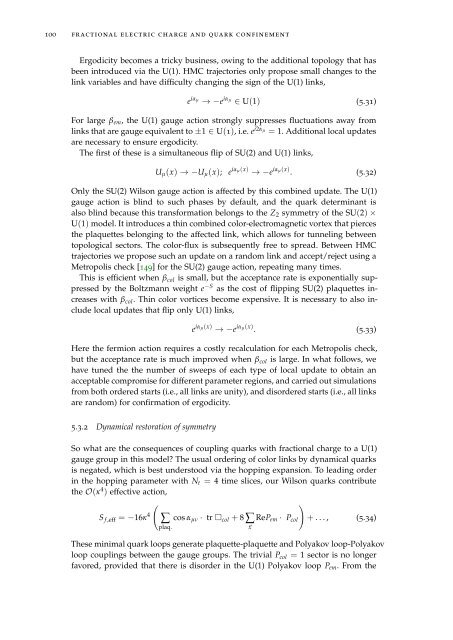Topology, symmetry, and phase transitions in lattice gauge ... - tuprints
Topology, symmetry, and phase transitions in lattice gauge ... - tuprints
Topology, symmetry, and phase transitions in lattice gauge ... - tuprints
Create successful ePaper yourself
Turn your PDF publications into a flip-book with our unique Google optimized e-Paper software.
100 fractional electric charge <strong>and</strong> quark conf<strong>in</strong>ement<br />
Ergodicity becomes a tricky bus<strong>in</strong>ess, ow<strong>in</strong>g to the additional topology that has<br />
been <strong>in</strong>troduced via the U(1). HMC trajectories only propose small changes to the<br />
l<strong>in</strong>k variables <strong>and</strong> have difficulty chang<strong>in</strong>g the sign of the U(1) l<strong>in</strong>ks,<br />
e iα µ<br />
→ −e iα µ<br />
∈ U(1) (5.31)<br />
For large β em , the U(1) <strong>gauge</strong> action strongly suppresses fluctuations away from<br />
l<strong>in</strong>ks that are <strong>gauge</strong> equivalent to ±1 ∈ U(1), i.e. e i2α µ<br />
= 1. Additional local updates<br />
are necessary to ensure ergodicity.<br />
The first of these is a simultaneous flip of SU(2) <strong>and</strong> U(1) l<strong>in</strong>ks,<br />
U µ (x) → −U µ (x); e iα µ(x) → −e iα µ(x) . (5.32)<br />
Only the SU(2) Wilson <strong>gauge</strong> action is affected by this comb<strong>in</strong>ed update. The U(1)<br />
<strong>gauge</strong> action is bl<strong>in</strong>d to such <strong>phase</strong>s by default, <strong>and</strong> the quark determ<strong>in</strong>ant is<br />
also bl<strong>in</strong>d because this transformation belongs to the Z 2 <strong>symmetry</strong> of the SU(2) ×<br />
U(1) model. It <strong>in</strong>troduces a th<strong>in</strong> comb<strong>in</strong>ed color-electromagnetic vortex that pierces<br />
the plaquettes belong<strong>in</strong>g to the affected l<strong>in</strong>k, which allows for tunnel<strong>in</strong>g between<br />
topological sectors. The color-flux is subsequently free to spread. Between HMC<br />
trajectories we propose such an update on a r<strong>and</strong>om l<strong>in</strong>k <strong>and</strong> accept/reject us<strong>in</strong>g a<br />
Metropolis check [149] for the SU(2) <strong>gauge</strong> action, repeat<strong>in</strong>g many times.<br />
This is efficient when β col is small, but the acceptance rate is exponentially suppressed<br />
by the Boltzmann weight e −S as the cost of flipp<strong>in</strong>g SU(2) plaquettes <strong>in</strong>creases<br />
with β col . Th<strong>in</strong> color vortices become expensive. It is necessary to also <strong>in</strong>clude<br />
local updates that flip only U(1) l<strong>in</strong>ks,<br />
e iα µ(x) → −e iα µ(x) . (5.33)<br />
Here the fermion action requires a costly recalculation for each Metropolis check,<br />
but the acceptance rate is much improved when β col is large. In what follows, we<br />
have tuned the the number of sweeps of each type of local update to obta<strong>in</strong> an<br />
acceptable compromise for different parameter regions, <strong>and</strong> carried out simulations<br />
from both ordered starts (i.e., all l<strong>in</strong>ks are unity), <strong>and</strong> disordered starts (i.e., all l<strong>in</strong>ks<br />
are r<strong>and</strong>om) for confirmation of ergodicity.<br />
5.3.2 Dynamical restoration of <strong>symmetry</strong><br />
So what are the consequences of coupl<strong>in</strong>g quarks with fractional charge to a U(1)<br />
<strong>gauge</strong> group <strong>in</strong> this model? The usual order<strong>in</strong>g of color l<strong>in</strong>ks by dynamical quarks<br />
is negated, which is best understood via the hopp<strong>in</strong>g expansion. To lead<strong>in</strong>g order<br />
<strong>in</strong> the hopp<strong>in</strong>g parameter with N t = 4 time slices, our Wilson quarks contribute<br />
the O(κ 4 ) effective action,<br />
( )<br />
S f ,eff = −16κ 4 ∑ cos α µν · tr □ col + 8 ∑ ReP em · P col + . . . , (5.34)<br />
plaq.<br />
⃗x<br />
These m<strong>in</strong>imal quark loops generate plaquette-plaquette <strong>and</strong> Polyakov loop-Polyakov<br />
loop coupl<strong>in</strong>gs between the <strong>gauge</strong> groups. The trivial P col = 1 sector is no longer<br />
favored, provided that there is disorder <strong>in</strong> the U(1) Polyakov loop P em . From the
















